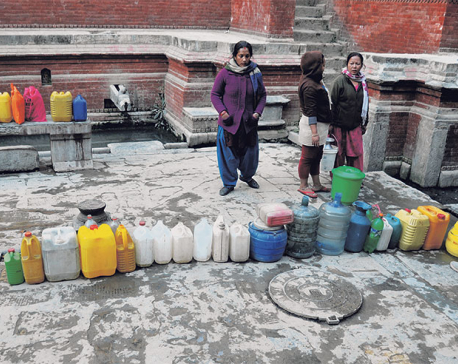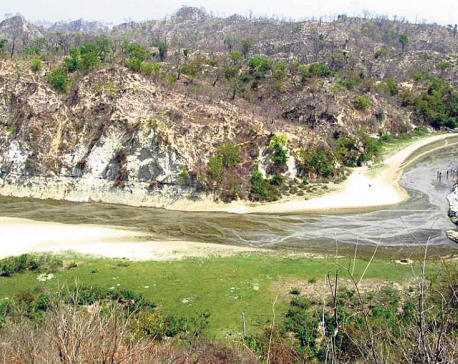
OR
Revival of water sources possible: Study
Published On: October 25, 2016 01:10 AM NPT By: Ram Saran Tamang
KATHMANDU, Oct 25: Villages lying high in the mid-hills of Nepal started facing increasing shortage of water since the early 1980s, according to a recent research report.
The recently-released report “Springs, Storage Towers, and Water Conservation in the Midhills of Nepal” has attributed many factors for the drying up of water sources. According to the report, increase in population, changes in land use, infrastructure development, and now climate change have resulted in the shortage of water.
The flow of water from many springs has lessened, permanent springs have become seasonal, and seasonal springs have dried up completely. In some areas, the problem has become so acute that people are considering abandoning their villages, the report highlighted the adverse effects caused by the water crisis.
The drying up of springs and ponds since the past few decades has left a profound impact in the livelihoods of many communities, according to the report.
“Over the past 15 years, many farmers across the hills have abandoned their agricultural lands due to severe crisis of water for irrigation,” states the report.
The report published by International Centre for Integrated Mountain Development (ICIMOD), however, states that the revival of water sources is possible. The organization and its local partner, Nepal Water Conservation Foundation, had initiated a pilot project, Spring Revival under Koshi Basin Programme (KBP), three years ago in two water-scarce sites of Kavre district. The project, which was initiated with an objective to revitalize already dried up or dying water sources, has left a visible impact on the communities lately, claimed ICIMOD.
The project followed various methods of spring recharge schemes such as eyebrow pits, slope vegetation and other methods for trapping monsoon rainfall and increasing infiltration of underground water level.
Six sites were selected for pond rehabilitation by ICIMOD, including three in Daraune Pokhari and three in Tinpiple in partnership with the local communities.
“The knowledge at the community has now been enhanced on the importance of reviving drying up springs and recharging/rehabilitating ponds,” reads the report. The project hopes to take the initiative of reviving springs and recharging ponds across the mid-hills of the country.
The report has concluded that the villagers in various localities are unaware of the link between water recharge and flow of spring water, and have not considered that they themselves might be able to improve the water supply situation through simple (re)construction of ponds.
Emphasizing on the need of locals' control over water situation, the report states that local political divides, social discrimination, commercial interests in exploiting water supplies, and lack of a functioning local administration, as well as a tendency to expect and rely upon outside support, hinder the ability of local groups to take full control and ownership of such schemes.
Active local participation is the key to success in this type of initiative, thus efforts should focus on communication and knowledge sharing to raise awareness of the problems and the ways in which local people can themselves actively improve the water supply situation, the report concluded.
You May Like This

UNHOLY WATER! 16 OUT OF 18 WATER SOURCES POLLUTED IN BHAKTAPUR
BHAKTAPUR, July 12: Sixteen of the 18 water sources of Bhaktapur contain chloroform bacteria, according to water test carried out by... Read More...

Declining water sources hit livelihoods of Jumla folks
JUMLA, May 28: Kali Bahadur Rawat of Lihi Gaun of Jumla claims that his village was known as the storehouse of... Read More...

Water sources 'disappearing' in Chure
SAPTARI, April 27: Water crisis is deepening in the plains over the years. According to the locals, rivers and other water... Read More...





Just In
- MoHP cautions docs working in govt hospitals not to work in private ones
- Over 400,000 tourists visited Mustang by road last year
- 19 hydropower projects to be showcased at investment summit
- Global oil and gold prices surge as Israel retaliates against Iran
- Sajha Yatayat cancels CEO appointment process for lack of candidates
- Govt padlocks Nepal Scouts’ property illegally occupied by NC lawmaker Deepak Khadka
- FWEAN meets with President Paudel to solicit support for women entrepreneurship
- Koshi provincial assembly passes resolution motion calling for special session by majority votes






_20220508065243.jpg)






Leave A Comment